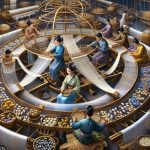Discover the untold story of how fabric transformed historical attire. You’ll be amazed at the early innovations in ancient civilizations and the evolution of textile production techniques.
Immerse yourself in the impact fabric had on fashion trends, as well as its significance as a symbol of social status and cultural identity.
In this article, we’ll explore how fabric revolutionized historical dress codes, unveiling a fascinating narrative that has been overlooked for far too long.
Table of Contents
Early Fabric Innovations in Ancient Civilizations
Discover how ancient civilizations pioneered early fabric innovations, transforming the way people dressed throughout history.
Ancient weaving techniques and fabric dyeing methods played a crucial role in the development of early fabrics. In ancient civilizations such as Egypt and Mesopotamia, weaving was a highly skilled craft that involved intricate patterns and designs. These civilizations used various weaving techniques, such as the warp and weft method, to create fabrics of different textures and strengths.
Fabric dyeing methods were also important in ancient civilizations. They used natural dyes derived from plants, insects, and minerals to add vibrant colors to their fabrics. Ancient Egyptians, for example, used madder root to obtain red dye and indigo plant for blue dye. These natural dyes not only added color but also had symbolic meanings associated with different social classes and religious beliefs.
The early fabric innovations of ancient civilizations laid the foundation for textile production and fashion as we know it today. They introduced techniques and methods that are still used in modern textile industries. The advancements in weaving and fabric dyeing allowed for the creation of more intricate and beautiful fabrics, giving people the opportunity to express their creativity through clothing.
The ancient civilizations’ contributions to fabric innovations continue to influence the way we dress and design clothes today.
The Evolution of Textile Production Techniques
As you delve deeper into the untold story of how fabric revolutionized historical attire, it’s important to understand the evolution of textile production techniques and how they’ve shaped the clothes we wear today. The advancements in textile manufacturing have had a profound impact on the textile industry and the way garments are created.
-
Invention of the Spinning Wheel: The spinning wheel was a game-changer in the textile industry. It replaced the time-consuming and labor-intensive process of hand-spinning fibers into thread. With the spinning wheel, spinning became faster and more efficient, leading to increased production of textiles.
-
Introduction of the Power Loom: The power loom was a significant development in textile production. It mechanized the weaving process, allowing for the mass production of fabrics. With the power loom, the speed of weaving increased exponentially, making textiles more accessible and affordable.
-
Adoption of Synthetic Fibers: The invention and widespread use of synthetic fibers, such as nylon and polyester, revolutionized the textile industry. These fibers offered durability, versatility, and affordability, leading to the production of a wide range of fabrics for various purposes.
These textile manufacturing advancements have greatly impacted the textile industry, transforming the way garments are produced. Today, we enjoy the convenience of mass-produced clothing and a variety of fabrics that cater to our diverse needs and preferences. The evolution of textile production techniques continues to shape the clothes we wear, making them more accessible, durable, and stylish.
The Impact of Fabric on Fashion Trends
With the evolution of textile production techniques, fabric has had a significant impact on shaping fashion trends throughout history. Today, the influence of fabric on contemporary fashion is more prominent than ever. Designers and consumers alike are becoming increasingly aware of the importance of sustainable fabric choices in the fashion industry.
| Influence of Fabric on Contemporary Fashion | ||
| Sustainable fabric choices in the fashion industry | ||
The influence of fabric on contemporary fashion cannot be overstated. Designers are constantly experimenting with new fabrics and materials to create innovative and unique designs. From luxurious silk to durable denim, the type of fabric used can completely transform the look and feel of a garment. In recent years, there has been a growing emphasis on sustainable fabric choices in the fashion industry. Designers and brands are opting for eco-friendly materials such as organic cotton, hemp, and recycled polyester. This shift towards sustainability reflects the growing awareness of the environmental impact of the fashion industry and the desire to make more ethical choices.
Fabric as a Symbol of Social Status and Cultural Identity
Fabric, as an indicator of social status and cultural identity, has played a pivotal role in shaping historical attire. Throughout history, fabric has been intricately linked to economic inequality, with certain fabrics being reserved for the wealthy elite. Silk, for example, was a luxurious fabric that symbolized wealth and power. It was often worn by nobles and royalty, showcasing their elevated social status. On the other hand, commoners were limited to wearing simpler fabrics such as wool or linen.
Fabric has also served as a form of self-expression, allowing individuals to showcase their cultural identity. Different regions and communities have developed their own unique fabrics and textile traditions, which are deeply rooted in their cultural heritage. These fabrics not only reflect the creativity and craftsmanship of the people but also serve as a visual representation of their cultural identity. For example, the intricate patterns and vibrant colors of traditional African fabrics like kente cloth and Ankara prints are a testament to the rich cultural heritage of the African continent.
How Fabric Revolutionized Historical Dress Codes
By revolutionizing the construction and design of clothing, fabric has dramatically transformed historical dress codes, giving individuals unparalleled opportunities for self-expression and style. Innovations in fabric technology have played a vital role in shaping the way people dress throughout history. Fabrics such as silk, cotton, and wool haven’t only provided comfort and protection but have also been used to communicate social status and cultural identity.
One of the most significant advancements in fabric technology was the invention of the spinning wheel in the Middle Ages. This innovation allowed for the mass production of thread, leading to the availability of more affordable fabrics. As a result, people from different social classes could now afford to wear garments made from luxurious fabrics like silk and velvet.
In addition to affordability, advancements in dyeing techniques also had a profound impact on historical dress codes. The discovery of natural dyes and the invention of synthetic dyes allowed for a wider range of colors and patterns in fabrics. This gave individuals the opportunity to express their creativity and personal style through their clothing choices.
Moreover, the introduction of new weaving techniques, such as jacquard looms and the power loom during the Industrial Revolution, made it possible to create intricate patterns and designs on fabrics. This revolutionized historical dress codes by introducing a variety of textures and embellishments.
Frequently Asked Questions
How Did Ancient Civilizations Obtain the Materials for Fabric Production?
To produce fabric, ancient civilizations sourced materials through various methods. They obtained fibers from plants, animals, and even insects. These materials were then spun, woven, and dyed to create the fabric that revolutionized historical attire.
Were There Any Specific Textile Production Techniques That Were Unique to a Particular Civilization?
Unique textile techniques were developed by various civilizations, each with its own cultural significance. These techniques allowed civilizations to create distinct fabrics, patterns, and designs that represented their identity and traditions.
Did Fabric Play a Role in Religious or Ceremonial Rituals in Ancient Civilizations?
Fabric played a significant role in ancient religious rituals and influenced ceremonial traditions. It was used to create sacred garments and adornments, symbolizing spiritual beliefs and societal values.
How Did Fabric Impact the Economic Systems of Ancient Civilizations?
Fabric impacted the economic systems of ancient civilizations by playing a crucial role in trade. The production and trade of textiles created economic opportunities and influenced social hierarchies, as those who controlled fabric production held significant power.
What Were Some of the Challenges Faced by Designers and Tailors When Fabric Revolutionized Historical Dress Codes?
Designers and tailors faced numerous challenges when fabric revolutionized historical dress codes. The advancements in fabric production and textile techniques impacted ancient civilizations’ economic systems, religious and ceremonial rituals, requiring adaptation and innovation.
- How Does Ring Spun Cotton Affect Garment Fit and Shape Retention? - August 13, 2024
- What Are the Challenges in Producing Ring Spun Cotton? - August 13, 2024
- Is Ring Spun Cotton Suitable for Plus-Size Clothing? - August 13, 2024



